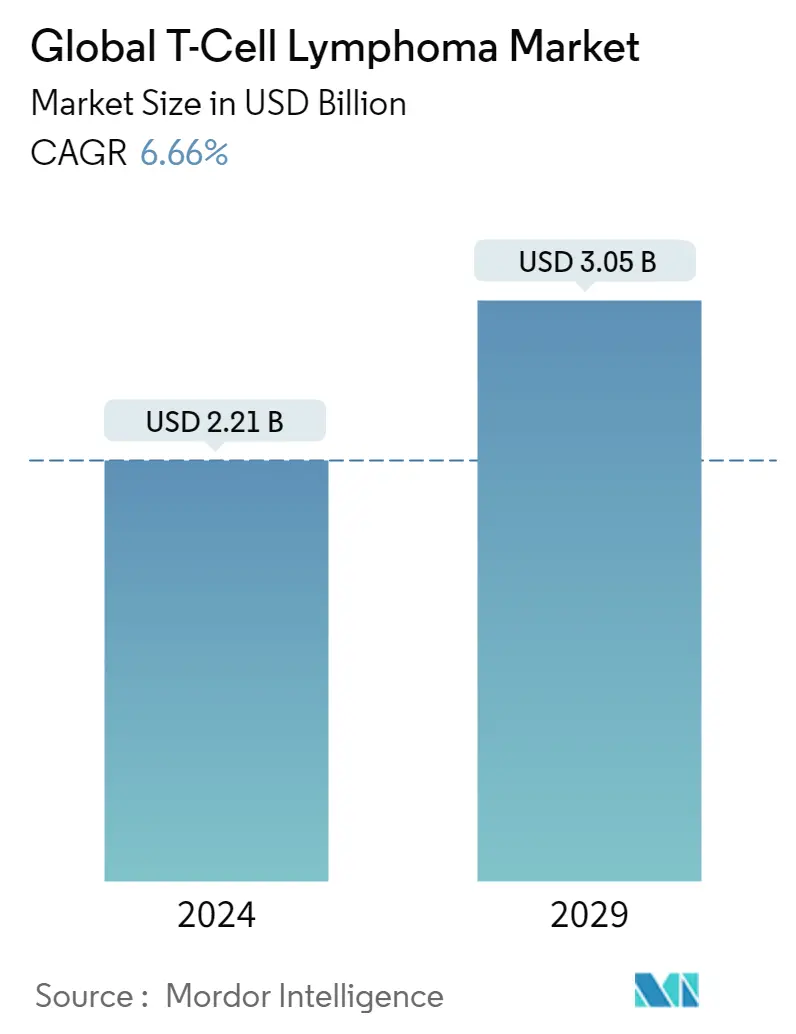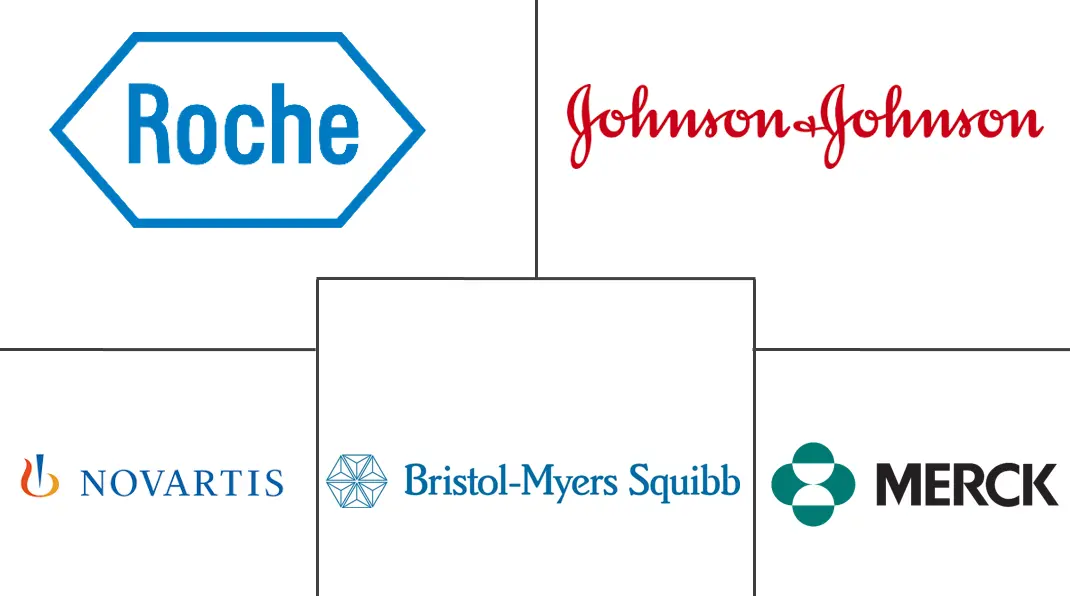Market Size of Global T-Cell Lymphoma Industry

| Study Period | 2019 - 2029 |
| Market Size (2024) | USD 2.21 Billion |
| Market Size (2029) | USD 3.05 Billion |
| CAGR (2024 - 2029) | 6.66 % |
| Fastest Growing Market | Asia Pacific |
| Largest Market | North America |
Major Players
*Disclaimer: Major Players sorted in no particular order |
T-Cell Lymphoma Market Analysis
The Global T-Cell Lymphoma Market size is estimated at USD 2.21 billion in 2024, and is expected to reach USD 3.05 billion by 2029, growing at a CAGR of 6.66% during the forecast period (2024-2029).
Due to the high transmission rate of COVID-19 and lack of treatment, many countries suffered, and they continue to bear a significant burden on their economies and healthcare systems. The COVID-19 outbreak may put patients with cutaneous lymphomas at additional risk of not receiving the necessary diagnostic procedures and treatment because they cannot access hospitals easily or due to healthcare resources limitations. Several guidelines for managing cutaneous lymphoma have been recently published to help dermatologists choose the right approach in the COVID-19 pandemic. However, these guidelines happen to be not applicable in countries that are still under a lockdown or do not have enough resources to implement the plan.
Moreover, the outbreak of COVID-19 impacted the cancer T-cell lymphoma market, as hospitals and healthcare services were significantly reduced due to social distancing measures enforced globally. The COVID-19 pandemic also affected the global economy and showed a huge impact on the general hospital care functioning for non-COVID-19 patients in hospitals across the world.
The growth of the T-cell lymphoma market is attributed to the rise in lymphoma cancer incidence due to radiations, an increase in the number of T-cell lymphoma-specific therapies, and the risk of lymphoma due to autoimmune disorders.
According to Leukemia & Lymphoma Society 2021, 186,400 people in the United States were diagnosed with leukemia and lymphoma in 2021. In addition, 825,651 people lived with lymphoma in the United States, 152,671 people lived with Hodgkin lymphoma, and 672,980 people lived with non-Hodgkin lymphoma. T-cell lymphoma is significantly contributing to non-Hodgkin lymphoma, which further boosts the overall market growth.
In addition, the growing uptake of premium-priced products such as Keytruda, Opdivo, and immune checkpoint inhibitors and the launch of several novel therapies with label extension of commercialized products are also boosting the overall market growth. However, the high cost associated with T-cell lymphoma treatment and the adverse side effects of therapies have been obstructing the overall market growth.
T-Cell Lymphoma Industry Segmentation
As per the scope of the report, lymphoma occurs when a lymphocyte, a type of white blood cell, is out of control inside the body, affecting the body's immune capacity to fight against infection. Lymphomas are grouped as Hodgkin (abnormal B-cells) and non-Hodgkin (developing from abnormal T-cells or B-cells) lymphomas. The T-cell lymphoma market is segmented by type of lymphoma (peripheral T-cell lymphoma, cutaneous T-cell Lymphoma, anaplastic large cell lymphoma, angio-immuno-blastic T-cell lymphoma, other types of lymphoma), T-cell lymphoblastic lymphoma), type of therapy (radiotherapy, chemotherapy, immunotherapy, stem cell transplantation, other types of therapies) and geography (North America, Europe, Asia-Pacific, Middle East & Africa, and South America). The market report also covers the estimated market sizes and trends for 17 different countries across major regions globally. The report offers the value (in USD million) for the above segments.
| By Type of Lymphoma | ||||||
| ||||||
| T-cell Lymphoblastic Lymphoma |
| By Type of Therapy | |
| Radiotherapy | |
| Chemotherapy | |
| Immunotherapy | |
| Stem Cell Transplantation | |
| Other Types of Therapies |
| Geography | ||||||||
| ||||||||
| ||||||||
| ||||||||
| ||||||||
|
Global T-Cell Lymphoma Market Size Summary
The T-cell lymphoma market is poised for significant growth over the forecast period, driven by an increase in lymphoma cancer incidence and the development of T-cell lymphoma-specific therapies. The market's expansion is further supported by the rising prevalence of autoimmune disorders that heighten lymphoma risk, as well as the growing adoption of premium-priced therapies such as immune checkpoint inhibitors. Despite the challenges posed by the COVID-19 pandemic, which disrupted healthcare services and delayed cancer care, the market is expected to benefit from favorable reimbursement policies and the introduction of novel therapies. The pandemic highlighted the vulnerabilities in cancer care, but it also underscored the importance of advancing treatment options, which is expected to contribute to market growth.
In North America, the T-cell lymphoma market is bolstered by a high prevalence of the condition, active research and development, and strategic collaborations among key market players. The region's market growth is further supported by the presence of major companies like Johnson & Johnson, Novartis, and Bristol Myers Squibb, which are actively involved in developing and commercializing therapies. The competitive landscape is characterized by significant investments in clinical trials and collaborations aimed at enhancing treatment efficacy. As the market continues to evolve, the focus on innovative therapies and strategic partnerships is expected to drive further advancements and expand the market's reach.
Global T-Cell Lymphoma Market Size - Table of Contents
-
1. MARKET DYNAMICS
-
1.1 Market Overview
-
1.2 Market Drivers
-
1.2.1 Rise in Lymphoma Cancer Incidence
-
1.2.2 Advancements in T-cell Lymphoma-specific Therapies
-
1.2.3 Risk of Lymphoma due to Autoimmune Disorders
-
-
1.3 Market Restraints
-
1.3.1 High Cost of Treatment
-
1.3.2 Adverse Side Effects of Therapies
-
-
1.4 Porter's Five Forces Analysis
-
1.4.1 Threat of New Entrants
-
1.4.2 Bargaining Power of Buyers/Consumers
-
1.4.3 Bargaining Power of Suppliers
-
1.4.4 Threat of Substitute Products
-
1.4.5 Intensity of Competitive Rivalry
-
-
-
2. MARKET SEGMENTATION (Market Size by Value - USD million)
-
2.1 By Type of Lymphoma
-
2.1.1 Peripheral T-cell Lymphoma
-
2.1.1.1 Cutaneous T-cell Lymphoma
-
2.1.1.2 Anaplastic Large Cell Lymphoma
-
2.1.1.3 Angio-immuno-blastic T-cell Lymphoma
-
2.1.1.4 Other Types of Lymphoma
-
-
2.1.2 T-cell Lymphoblastic Lymphoma
-
-
2.2 By Type of Therapy
-
2.2.1 Radiotherapy
-
2.2.2 Chemotherapy
-
2.2.3 Immunotherapy
-
2.2.4 Stem Cell Transplantation
-
2.2.5 Other Types of Therapies
-
-
2.3 Geography
-
2.3.1 North America
-
2.3.1.1 United States
-
2.3.1.2 Canada
-
2.3.1.3 Mexico
-
-
2.3.2 Europe
-
2.3.2.1 Germany
-
2.3.2.2 United Kingdom
-
2.3.2.3 France
-
2.3.2.4 Italy
-
2.3.2.5 Spain
-
2.3.2.6 Rest of Europe
-
-
2.3.3 Asia-Pacific
-
2.3.3.1 China
-
2.3.3.2 Japan
-
2.3.3.3 India
-
2.3.3.4 Australia
-
2.3.3.5 South Korea
-
2.3.3.6 Rest of Asia-Pacific
-
-
2.3.4 Middle East & Africa
-
2.3.4.1 GCC
-
2.3.4.2 South Africa
-
2.3.4.3 Rest of Middle East & Africa
-
-
2.3.5 South America
-
2.3.5.1 Brazil
-
2.3.5.2 Argentina
-
2.3.5.3 Rest of South America
-
-
-
Global T-Cell Lymphoma Market Size FAQs
How big is the Global T-Cell Lymphoma Market?
The Global T-Cell Lymphoma Market size is expected to reach USD 2.21 billion in 2024 and grow at a CAGR of 6.66% to reach USD 3.05 billion by 2029.
What is the current Global T-Cell Lymphoma Market size?
In 2024, the Global T-Cell Lymphoma Market size is expected to reach USD 2.21 billion.

